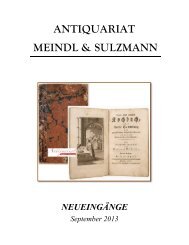Japanese Prints
Japanese Prints
Japanese Prints
Create successful ePaper yourself
Turn your PDF publications into a flip-book with our unique Google optimized e-Paper software.
76<br />
<strong>Japanese</strong> plum and bamboo, the pine is counted as one of the most<br />
auspicious plants in Japan. considered to be the most aristocratic<br />
of all trees, the imperial gardens of Japan are full of pines. In fact<br />
the pine is the only tree in Japan with an official title: goko no taifu.<br />
Befitting its status, the samurai as well as other nobles and<br />
aristocrats commissioned artists to paint pine trees as a means of<br />
wishing for long-life and auspiciousness.<br />
Plum blossom<br />
Symbolic of purity and nobility due to its enriched smell and elegant<br />
appearance. In the cold winter snow, the plum blossom grows new<br />
flowers from seemingly dead branches. The depiction of a five petal<br />
blossom represents new life at the end of winter and is highly<br />
revered as an auspicious symbol in Japan.<br />
Rabbit<br />
The white rabbit is associated with the moon. According to Indian<br />
legend it is said that Buddha would have been reincarnated as a hare<br />
in order to sacrifice himself as food for the Hindu God “Indra”. As<br />
a reward the rabbit was immortalised in the moon.<br />
Racquet<br />
The racquet is used traditionally in games played during the new<br />
Year festivities. It symbolises good health and fortune as well as<br />
helping to drive away evil spirits from children.<br />
Sacred Shinto rope<br />
The shimenawa is a sacred rope that is hung before a Shinto shrine,<br />
over the entrance gate to a dwelling-house or round a place which<br />
is considered sacred or has to be kept sacred. According to Shinto<br />
belief, no evil can pass beyond the line of the shimenawa.<br />
Shachihoko<br />
fish shaped ornaments known as Shachi or Shachihoko were<br />
frequently used as roof ornaments in the Edo period (1600-1868)<br />
and found atop castles, tower gates, and samurai homes. These<br />
ornaments are placed at both ends of the main roof ridge, with the<br />
male Shachi placed on the left and the female Shachi on the right.<br />
The creatures are thought to provide protection against fire, as they<br />
are attributed with the power to control rain.<br />
Sword<br />
Many Buddhist or Shinto gods in <strong>Japanese</strong> mythology exhibit<br />
swords to show their ability to cut through ignorance and evil.<br />
Tiger<br />
In Japan the tiger was a beast as mythical as the dragon. In art it<br />
was drawn in accordance with the drawings handed down by the<br />
old chinese artists. The tiger represents the west and autumn (as a<br />
zodiacal sign it represents summer). It is symbolic of the Yang male<br />
principle in nature. Tigers are often depicted between the bamboos,<br />
a Buddhist symbol of the weak protecting the strong.<br />
Torii Gate<br />
Torii gates mark the sites of sacred places for both Buddhist and<br />
Shinto shrines. They are symbols of sanctity, purification and mark<br />
the borders between the temporal and spiritual realms.<br />
Umbrella<br />
The umbrella is a traditional Asian symbol of both protection and<br />
royalty. The ability to protect oneself against inclement weather has<br />
always been a symbol of status. In Oriental thought, the fact that<br />
the umbrella protected the bearer from the scorching heat of the sun<br />
was transferred into the religious sphere as a “protection against the<br />
heat of defilements.” The coolness of its shade symbolizes<br />
protection from the heat of suffering, desire, and other spiritually<br />
harmful forces.<br />
Willow<br />
The Ainu people of the <strong>Japanese</strong> island of Hokkaido believed that<br />
the willow was their ancestor tree. They thought that the human<br />
backbone was originally made of willow wood, and special willow<br />
fetishes were given to children as guardian spirits. The willow in<br />
Japan is also a good luck symbol as well as a representation of<br />
elegant, graceful beauty.<br />
Wisteria<br />
In ancient Japan, the colour of the wisteria was reserved only for<br />
the aristocracy. It symbolised long -life as well as marital harmony.<br />
Sparrow<br />
The sparrow is a traditional symbol of happiness. Associated with<br />
bamboo, the two symbols are often shown together to depict<br />
friendship.

















